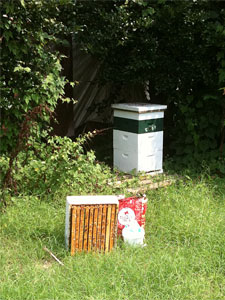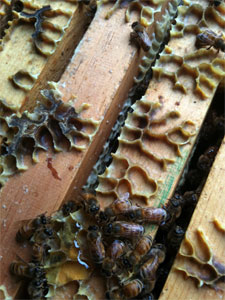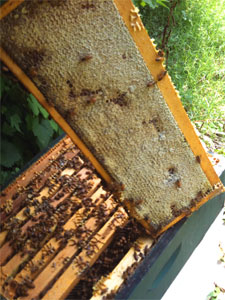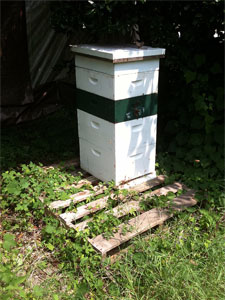 I look after ten hives now, one of which does not belong to me: it's the colony located at the Lederer Youth Garden in NE DC. The hive was started from a package this Spring, and I had a devil of a time getting them going: I donated the bees, equipment and all, a few months ago, so they are officially government honeybees.
I look after ten hives now, one of which does not belong to me: it's the colony located at the Lederer Youth Garden in NE DC. The hive was started from a package this Spring, and I had a devil of a time getting them going: I donated the bees, equipment and all, a few months ago, so they are officially government honeybees. Here's the hive when I arrived today. The medium sitting on it's side is full of recently extracted frames from the roof bees, something I hope will give the girls a head start on additional winter stores. (I guess that means that DC is now the owner of yet another chunk of hive gear!)
My last visit took place on July 8, just before travel. At that time, I checked that the queen was still laying, gave them that green medium super with a few frames of comb, filled the feeder and hoped for the best. Those hopes were truly fufilled!
 I also brought cappings and honey to put in the feeder, but decided to take a bit of a look inside since so much time had passed.
I also brought cappings and honey to put in the feeder, but decided to take a bit of a look inside since so much time had passed. Here's a confession: even though it had been almost a month since I had even looked at this hive, even though it is a particularly important and privileged colony, it took every bit of self-discipline I had to push forward> You see, it was about 95 degrees F (33 degrees C) by the time I arrived, and I had been stupid enough not to bring any water or socks into which to tuck my jeans!
But the reward was great. Sweet, good-tempered bees were present throughout the top box, and by peeking between the frames I could see that every single one was filled with capped honey. And some drone brood. Hmmm.
 This was the second frame in, even the frame at the edge of the box was completely drawn and filled. Somewhat worrisome: the third frame in had a mass of drone brood, and nothing but drone brood. This was a concern because I have dealt with three unreliable young queens this year, and even though the weather is frying-hot at this time of year, we really have to be thinking about the upcoming winter and whether the queen who is in place will be producing that big batch of fat, healthy cold weather bees we need to take us from October through the end of January (at least).
This was the second frame in, even the frame at the edge of the box was completely drawn and filled. Somewhat worrisome: the third frame in had a mass of drone brood, and nothing but drone brood. This was a concern because I have dealt with three unreliable young queens this year, and even though the weather is frying-hot at this time of year, we really have to be thinking about the upcoming winter and whether the queen who is in place will be producing that big batch of fat, healthy cold weather bees we need to take us from October through the end of January (at least). So once again I had the rare privilege of hefting an 80-pound (about 30 kg) box full of bees and honey gently to its resting place on an inverted telescoping hive cover. Sigh. Luckily, even though it is August, the bees were in no mood to get sting-y and I had enough coordination to keep from squishing anyone.
Also luckily, the first deep frame I pulled from the top brood box was full full full of lovely flat-capped worker brood: mom just laid all those drones in some frame that was warped when I transferred it over before vacation!
So I put back the frame, cleaned up those blobs of honey on top of the whole box (the ones that the girls above are eating) and reserved them to give back, replaced the honey medium, added the extracted box, replaced the hive top feeder, filled it with the blobs I had scraped and several pounds of cappings and honey, and closed up for a while. If I play it right, I can let the girls clean up for about a week, come back to get the now-clean wax (I use it for making soap), and begin the heavy feeding regime that helps keep the hive happy and ready for the season ahead.
 Here's the newly-extended hive! Let's be honest: I've been worried how this season would go–anxious about potyential vandalism, about inadvertent interactions with the public, about being able to make the bees relevant to the whole gardening programme. The first two issues have simply not applied: the bees have a perfect location with the most desired flight path heading right over a field of corn, straight at a tree-lined creek. There are visual barriers and lines of trees and shrubs that keep anyone who is not already looking for the hive from stumbling across it.
Here's the newly-extended hive! Let's be honest: I've been worried how this season would go–anxious about potyential vandalism, about inadvertent interactions with the public, about being able to make the bees relevant to the whole gardening programme. The first two issues have simply not applied: the bees have a perfect location with the most desired flight path heading right over a field of corn, straight at a tree-lined creek. There are visual barriers and lines of trees and shrubs that keep anyone who is not already looking for the hive from stumbling across it. I'd like to do better for the people–especially the kids–who use that garden, and my usual ideas (a soap making seminar, a presentation with an observation hive) are not bad, but they are not really tuned in to the garden's specifics. So there is room for growth there, too.
9 comments:
Thanks so much for you blog,I live vicariously through it! I've always been interested in bees and the relationship the "keepers" and the bees have. I'm really encouraged to start my own colony and start my own relationship with these amazing little creatures.
I love your blog! I am trying to learn as much as I can about backyard beekeeping and hope to start my own hive(s) next spring. I've enjoyed reading your entries very much. Thank you for sharing.
another wonderful post, thx very much. as a second year beek, i find it very helpful to read of the trials, tribulations and hard-earned successes of (especially) more experienced beeks such as yourself.
i am now @ 3 hives and last week harvested my first full (medium) supe of honey frames. (woo hoo!) living in silicon valley, i am not as concerned about cold weather / letting them keep their honey so suspect i'll harvest a bit more, soon.
thx again for the posts and pics - all good stuff.
best,
hal
http://www.twobigcats.com
hey! i am visiting your blog for the first time and it is actually because i am looking for the dc bee keeper who supplied honey for the restaurant at which i work, Corduroy. Could this be you, by any chance? The honey was delicious, as was the ice cream, and I was hoping to learn more!
thanks,
gwen
www.farfromgruntled.blogspot.com
yup, that was me, but not from this hive!
I am glad that was you! I have sort of a strange question. I want to write an article for Bee Culture about how you, specifically how you as a small business person, find and work with other small businesses in the DC area. I am passionate about using local foods in local restaurants and stores, so this article would be right up my alley. I know you don't know me, are probably busy, and may not be interested, but I thought I would give it a shot. If you want to contact me, go to http://farfromgruntled.writersresidence.com
Thanks!
I'm finding your blog for the first time and want to say Congrats! on your success and to say Thanks for the thoughtful and lively blog.
I'm a first year newbee beek and am working with several friends on two hives. It's been a rocky year for us and we are struggling a bit. But we're optimistic for the remaining season.
But two quick questions about your recent entry:
Why did you have a feeder on your hive at this time of year? Do you feed the hive all summer?
Also...I'm curious about your comment about leaving wax and honey in the feeder for the bees to "clean up". Is this a tray feeder that sets inside the hive? How do the bees get to the bits of comb, etc. to clean it up. I like the idea of the girls doing the work of cleaning up the wax for you.
Thanks and I look forward to hearing more about your hives.
Jess
Two almost-quick responses!
Why a hive top feeder now? This particular hive was started from a relatively late package this year, and I had a hard time with all my packages this time. They need feeding support throughout their whole first year.
Question 2: giving the hive cappings wax and honey:
When I harvested this year's crop from other hives, I saved the capping honey and wax and included it when I gave sugar water to all my new hives: I hate to waste ANY of the honey the bees produce, and I can come back later to get the wax when I remove the hive top feeder and switch to a different feeding method this month (I find hive top feeders encourage robbing -- but I will make a post about this later)
Some beekeepers get the bees to clean the capping wax just by setting it out on a flat surface some distance from the hives, and letting the bees (and every other interested insect) have at it. But in this place, at this time, I feel this practice encourages robbing (since I cannot put anything very far from my hives on a small urban lot) plus the feeding frenzy could intimidate the neighbors. So I use this way to take the party inside, to the hives that need it most!
One consideration to look into is whether or not keeping bees is permitted in your area. Although honeybees are beneficial to any area, local regulations usually do not allow keeping bees in properties close to recreational places. Bees are beneficial in two ways. One, they help in pollinating plants and crops. Second, they drive away more aggressive insects, such as hornets and wasps. Be sure to place your hive away from houses and recreational places and you will have a gratifying beekeeping hobby.
Post a Comment